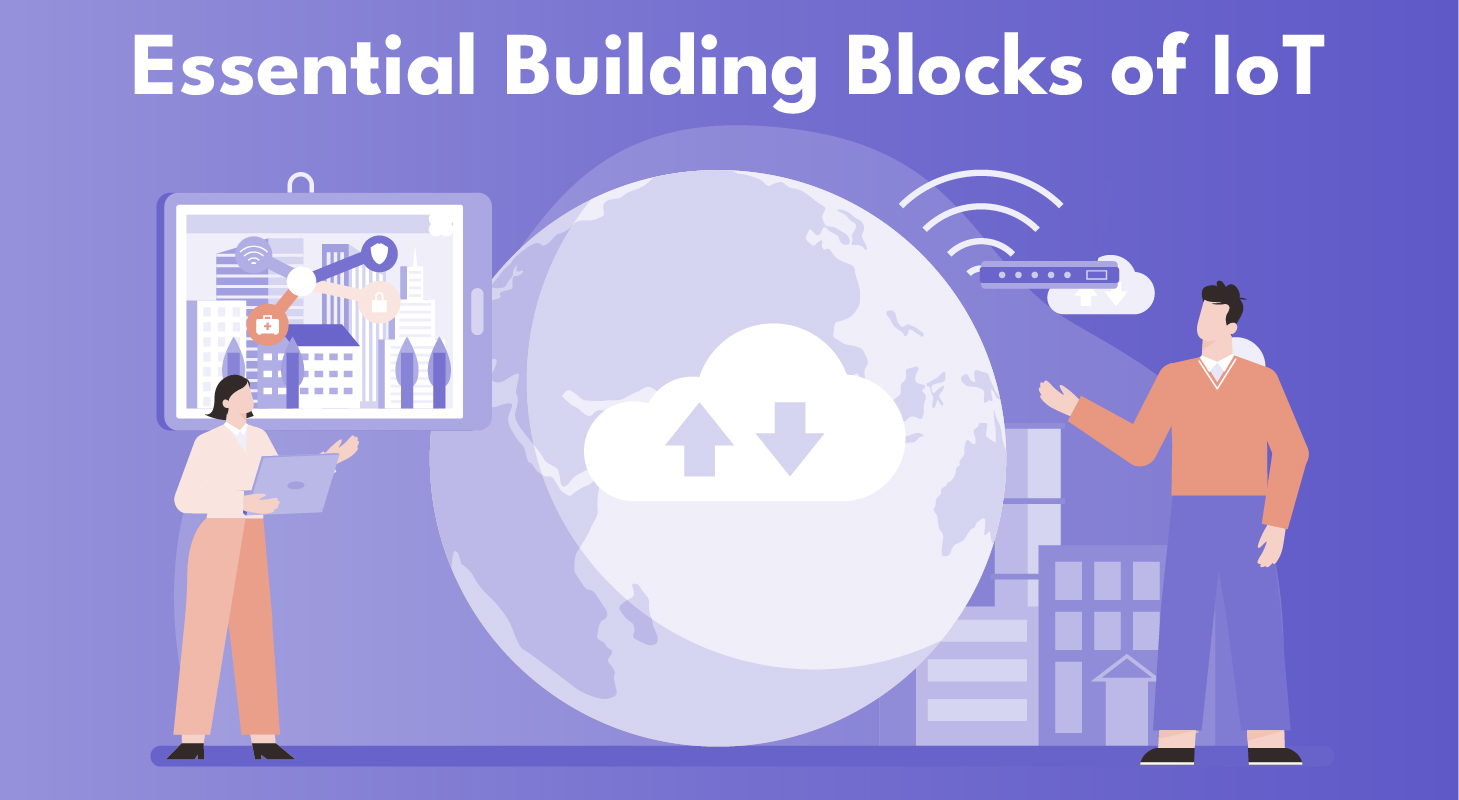The IoT (Internet of Things) is significantly transforming the way devices interact with businesses. IoT devices allow you to drive seamless data sharing and empower intelligent decision-making. Utilizing the potential of the IoT, businesses can enhance their operational efficiency, improve their customer experiences, and gain valuable insights into various processes.
The functioning of IoT devices primarily depends on certain building blocks of IoT such as IoT sensors, software, connectivity modules, and power sources. These IoT components assist devices in communicating with each other, processing information, and performing tasks autonomously, without any human intervention.
Each of these functioning components of IoT performs different activities like sensors to collect valuable data from the environment, which is then transmitted for further analysis. Later, the software processes this data and generates intelligent insights. Here connectivity modules like Wi-Fi, Bluetooth, and cellular technologies are also practical as they allow devices to stay connected and transmit information.
In addition to this, the power sources, such as batteries or energy harvesting help make sure that these devices operating their functioning continuously. These power sources are also workable even in remote or hard-to-reach locations.
In contrast to this, the physical designs of IoT, such as gateways and connectivity modules also play a crucial role in confirming their reliable operation. These designs ensure that the devices can withstand various environmental conditions while supporting critical functions such as automation, remote monitoring, and control.
Therefore, today, we will introduce you to the IoT devices' building blocks and their functionalities. So, let’s jump into the main content without any further ado!
The Building Blocks of IoT are
Sensors and Devices
For data collection we use sensors. Their design is specialized to detect and measure specific physical properties and events. It is of various types like temperature sensors, light, pressure, and motion sensors.
Devices do the job of collecting data from the environment. It ranges from simple sensors to complex smart devices. Smart devices perform advanced functionalities. These capture real-time information such as temperature, location, humidity, motion, etc. By integrating devices with the IoT system, devices facilitate continuous data collection. It can help businesses and organizations to make better data-driven decisions.
Connectivity Protocols
Connectivity Protocols in iot devices to connect, interact, and share data. These are available in a wide range which offers diverse features and functionalities to support various IoT applications. It defines the rules and standards for data exchange. It also maintains compatibility across heterogeneous IoT devices.
The functionalities provided by them offer varying ranges, power consumption levels, data transfer rates, and network coverage options. Some of the prominent examples of connectivity protocols are Wi-Fi, Cellular (3G, 4G, 5G), Bluetooth, Z-Wave, Zigbee, Ethernet, LoRaWAN, and Sigfox. Now let's understand about each briefly-
- Wi-Fi- It provides high-speed wireless connectivity for devices within a local area network (LAN). This provides applications with internet availability and ample power.
- Bluetooth- it provides short-range communication between devices. It is ideal for creating personal area networks and connecting peripherals.
- Zigbee and Z-Wave- Utilizing these both communication protocols of IoT, you don’t have any need for high power as it works on low-power and low-data rate protocols. Its applications are smart home automation applications that communicate over WiFi.
- Cellular Connectivity (3G, 4G, and 5G)- it provides wide-area coverage and high data transfer rates. It is ideal for IoT applications that require internet access outside local networks.
- Narrowband IoT (NB-IoT)- it is a cellular network. its applications are to optimize low-power and wide-area IoT applications. It provides extended coverage, and increased power efficiency. This makes it very suitable for applications like smart cities, agriculture, asset tracking, etc.
- Ethernet- it is a reliable wired connectivity that we use in industrial IoT deployments. This provides high data rates and stability. Examples include LoRaWAN and Sigfox which are long-range, low-power protocols
IoT gateway
These are intermediaries between IoT devices and the cloud. It bridges the gap between local networks and the internet. This enables them to perform functions like enabling connectivity, protocol translation, and data aggregation within IoT architectures. Now let's understand these functions in brief-
- Connectivity and Protocol Translation- these are centralized hubs that enable different devices with different connectivity protocols to communicate with each other and the cloud. These convert data formats and protocols, ensuring streamlined working of heterogeneous devices.
- Data Aggregation and Processing- IoT gateways collect data from multiple devices within their local network. It aggregates and filters it before transmitting it to the cloud or other systems. It reduces network congestion by processing data locally and forwarding only relevant information.l this optimizes bandwidth usage and improves the overall efficiency of the system.
- Edge Computing- IoT gateways allow data processing and analysis to occur closer to the source, reducing latency and enabling real-time decision-making. Real-life examples include industrial automation, smart grids, and autonomous vehicles.
- Security and Privacy- IoT gateways also implement security measures to protect IoT devices and their data, and communications. It performs all the security functions like enforcing access control policies, performing encryption/decryption, and detecting and mitigating security threats.
Also Read - IoT Levels Explained: A Deep Dive into the Internet of Things Hierarchy
Cloud Infrastructure
The Cloud Infrastructure of the IoT system supports the scalability, storage, processing, and analysis of vast amounts of data generated by IoT devices. It performs functionalities due to which we are able to implement the IoT implementations successfully.
- Scalability and Elasticity- With cloud infrastructure organizations can easily scale their resources up or down based on demand. Through this, they can meet changing needs and handle fluctuations in data volume and user traffic effectively
- Data Storage and Processing- Cloud platforms offer secure storage and management of large volumes of data. They provide data processing services like real-time analytics, artificial intelligence, and machine learning helping organizations to derive valuable insights and make data-driven decisions.
- Device Management and Provisioning- cloud infrastructure provides device management capabilities. This facilitates monitoring, updating, and configuring IoT devices remotely.
- Integrations- Cloud platforms enable integration with IoT systems, applications, and data sources. This allows organizations to consolidate and analyze data from multiple IoT deployments. They also provide APIs and data exchange mechanisms.
User Interface
User Inteface acts as a medium between humans and the IoT ecosystem. It facilitates interaction and control between humans and the IoT system. It allows users to navigate through various IoT applications, visualize data, and perform actions. The data visualization techniques include complex information such as graphs, charts, and dashboards. A friendly user interface allows individuals to remotely manage and configure IoT devices, define automation rules, and set preferences. The real-life use case includes a user who can adjust the temperature in their homes, schedule tasks, and receive alerts or notifications for that task through the IoT interface. This enhances the comfort and productivity in our lives.
Conclusion
IoT devices are at the heart of today's automated world and can empower innovations and reach them to the next level. A few of the most common and usable IoT devices are such as smart locks, doorbell cameras, smart TVs, wearables, and more. Organizations increasingly rely on these technologies to create their intelligent systems and understand the foundation of IoT devices.
To fully grasp the IoT ecosystem, it's important to dive into the functional blocks of IoT that make it all possible. By understanding how each building block operates and contributes to the overall system, you can gain deeper insight into the mechanics of IoT through our write-up. Therefore, let’s jump into the main content without dragging this ado anymore.
FAQs for Building Blocks of IoT
- What are the basic building blocks of IoT devices?
The basic building blocks of IoT devices include sensors, software, connectivity modules, and power sources. These components allow IoT devices to collect data, process it, communicate with each other, and have autonomous operations.
- How many building blocks of IoT are there?
Basically there are multiple building blocks of IoT. However, four are the primary building blocks of IoT which include sensors, software, connectivity modules, and power sources.
- Why are sensors important in IoT devices?
Sensors are the foundation of IoT devices because sensors assist in collecting real-world data and allow IoT devices to perceive their environment and make informed decisions.
- How do IoT devices communicate with each other?
IoT devices communicate with each other only through connectivity modules like Wi-Fi, Bluetooth, or cellular networks that enable them to share data and make interaction.
- How does software contribute to the functionality of IoT devices?
Software processes sensor data that manages device interactions, and guarantees high security while enabling automation and decision-making.



